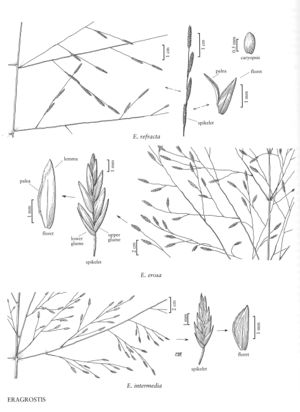Eragrostis refracta
Plants perennial; cespitose, with innovations, without rhizomes, not glandular. Culms 30-85(110) cm, glabrous and shiny below the nodes. Sheaths sparsely hairy at the apices, hairs to 6 mm; ligules 0.1-0.4 mm; blades 10-35 cm long, 2-5 mm wide, flat to involute, glabrous abaxially, scabridulous and sparsely pilose adaxially, hairs to 7 mm. Panicles (25)30-60 cm long, 25-40 cm wide, broadly ovate to obovate, open, diffuse; primary branches 5-25 cm, diverging 20-90° from the rachises, capillary; pulvini hairy or glabrous; pedicels 0.5-25 mm, appressed, only the terminal pedicels on each branch longer than the spikelets. Spikelets 4-18(23) mm long, 1.4-3.4 mm wide, linear-lanceolate, grayish-green or stramineous to purplish, with (4)9-30 florets; disarticulation tardy, basipetal, in the rachillas below the florets, glumes persistent. Glumes narrowly lanceolate, membranous; lower glumes 0.8-2.4 mm; upper glumes 1.5-2.6 mm; lemmas 1.4-2.8 mm, lanceolate, membranous, apices acute to acuminate; paleas 1-2.6 mm, hyaline to membranous, narrower than the lemmas, apices obtuse to acute; anthers 2, 0.3-0.5 mm, purplish or brownish. Caryopses 0.5-0.9 mm, ovoid to ellipsoid, finely striate, reddish-brown. 2n = 28.
Distribution
Md., N.J., Okla., Miss., Tex., La., Mo., Del., Ala., N.C., S.C., Va., Ark., Ga., Fla.
Discussion
Eragrostis refracta grows in sandy pinelands, savannahs, marshes, and woodlands on the coastal plain of the southeastern United States, at 0-150 m. It is not known from Mexico.
Selected References
None.
